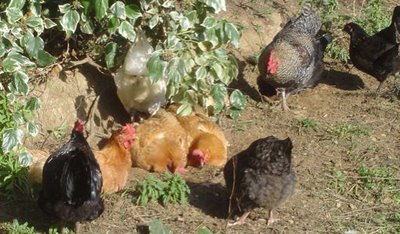
As I told you on my last blog, we’ve had our first guests in our gite a young couple from Derby, both doctors, and it was a pleasure to have them around. Their visit also meant that we were able to run our very first course, “Preparing Chickens for the Pot”. The inspiration for this was my own first experiences despatching a chicken and the inadequacies of instructions written in books; this is something one needs to be shown as it is essential—in our view—that the animal does not suffer unnecessarily during slaughter. Another inspiration was Hugh Fearnley Whittingstall’s recent River Cottage Treatment, a series of three hour long programmes on English television, where Hugh, an articulate and chatty ex-public schoolboy turned organic smallholder, showed fans of fast food where their food came from and tried to convince them—successfully in most cases—to care about how their meat was raised, killed and cooked.
The idea of our course was to allow a participant to eat a very French coq-au-vin (chicken cooked in red wine) having started with a live chicken and followed every stage in between. The “live”chicken was in fact a dead chicken I’d arranged to collect immediately after its humane slaughter on a nearby free-range chicken farm, neither plucked, nor drawn (dressed). That way we could discuss and try out the neck-wringing method of slaughter without stress to bird or person. We’d been though the legal requirements of slaughter, the guidance offered by the Humane Slaughter Association (HSA) and various devices one can buy and their relative merits. The HSA, for example, recommends stunning followed by bleeding or neck dislocation. However, a hand-held electric poultry stunner costs around £650 (€950/$1200) which is way out of reach to someone raising just a few chickens for personal consumption. From what I read, I was also not convinced that electric stunning is either 100%reliable or any more stress-free that other methods. As something that we occasionally have to do, and in preparation for the course, I’ve spent quite a bit of time on researching this. One of the people I spoke to was Neil who moved from London to Somerset to start producing organic Halal meat for sale and I think you might find his point of view interesting: “What is “humane” at the end of the day is cultural. The UK seems to think electrifying everything before it dies is humane, the rest of the world doesn’t. I go to the abattoir once a week and I hate stunning – I think it is painful and cruel but have to accept that unless I move to Birmingham or build my own abattoir I have to put up with it. When it comes to poultry I do them all at home. It is very simple – sharp knife across the top of the neck and they are dead in a second. Arguably they feel less pain than they do when getting electric currents through the brain.”

After we’d discovered (happily with a dead chicken as aforementioned) that a 4kg chicken is just too big to have its neck wrung by hand, we plucked it, comparing dry and wet plucking (dunked in a bucket of very hot water for a couple of seconds, the feathers just fall out) and then eviscerated it, variously called drawing or dressing, i.e., taking all the innards out. As I was with a hospital doctor, I was prepared to learn something myself and “Ann” (I have used a pseudonym so as not to embarrass Zoë if any of her colleagues should chance on this blog) very competently cut off the neck then cut around the vent and put her hand inside the carcass to withdraw the giblets or offal. Withdrawing one rather impressive and pale object, she remarked, “Oh, that’ll be a kidney. Now readers, you should know that Zoë, I mean “Ann” is a nephrologist, that’s someone who specialises in kidney diseases. As subtly as I could manage, I pointed out that what she was holding was not a kidney, but rather a cockerel bollock, a testicle, all very impressive as there’s two of them and they are at least as large as a man’s. The single, much smaller and purple kidney emerged moments later. “Ann’s” laughter at her own mistake or perhaps amazement at the size of the testicles was so loud it brought Gabrielle to the window to see what was going on. “Ann” swore me to secrecy, so don’t you tell anyone!
That fun moment aside, Gabrielle and I are both meat eaters and firmly believe that animals should be raised and slaughtered humanely and if you can’t take responsibility for all stages of the process as we are able to with our chickens, then perhaps that means only buying organic free-range non-factory farmed meat. For a challenging vegan point of view, visit VIVA’s website. Please do post a comment if you have something to say on this subject.
